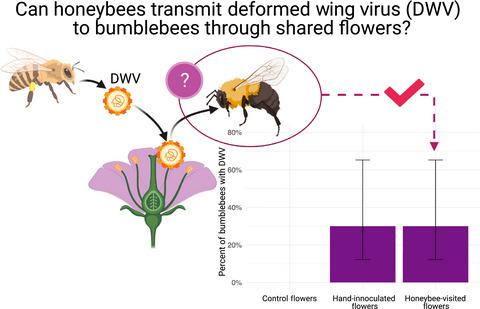当前位置:
X-MOL 学术
›
J. Appl. Ecol.
›
论文详情
Our official English website, www.x-mol.net, welcomes your feedback! (Note: you will need to create a separate account there.)
Flowers as dirty doorknobs: Deformed wing virus transmitted between Apis mellifera and Bombus impatiens through shared flowers
Journal of Applied Ecology ( IF 5.7 ) Pub Date : 2021-08-13 , DOI: 10.1111/1365-2664.13962 Phillip Alexander Burnham 1, 2 , Samantha A. Alger 3, 4 , Brendan Case 2, 5 , Humberto Boncristiani 6 , Laurent Hébert‐Dufresne 2, 5 , Alison K. Brody 1
中文翻译:

花作为脏门把手:变形的翅膀病毒通过共享花在蜜蜂和凤仙花之间传播
更新日期:2021-10-06
Journal of Applied Ecology ( IF 5.7 ) Pub Date : 2021-08-13 , DOI: 10.1111/1365-2664.13962 Phillip Alexander Burnham 1, 2 , Samantha A. Alger 3, 4 , Brendan Case 2, 5 , Humberto Boncristiani 6 , Laurent Hébert‐Dufresne 2, 5 , Alison K. Brody 1
Affiliation

|
- In light of bee declines, the importance of pollination services from managed and native bees to our agriculture and economy is of great political, scientific and public interest. Viruses, first observed in honeybees, have been documented in bumblebees and the prevalence and load of some RNA viruses have been associated with managed honeybees. Shared flowers may be the bridge across which viruses pass between bees but no study has yet demonstrated that bumblebees can pick up viruses while foraging on contaminated flowers.
- Here, through a series of mechanistic laboratory experiments and mathematical modelling, we ask whether viruses can be transmitted between bee genera on shared flowers and how transmission can be effectively mitigated.
- We demonstrated that deformed wing virus (DWV) can be transmitted from infected honeybees to bumblebees through the use of shared red clover. We were also able to show that the route may work in reverse and bumblebees could contribute to the spread as well.
- Our model showed that reducing vector-mediated transmission in honeybee colonies could potentially lead to a far greater reduction in bumblebee infection than simply reducing the number of honeybees. Additionally, we identified a dilution effect, whereby increasing floral abundance reduced transmission.
- Synthesis and applications. In this study, we showed that DWV may be spread between bee genera through the shared use of flowers. Through mathematical simulation, we identified two practical management options for reducing spread. The combination of treating honeybees effectively for the Varroa mite, a known vector of DWV, and increasing floral abundance where honeybees and native pollinators share the landscape were shown to reduce the spread of DWV within bee communities in simulations.
中文翻译:

花作为脏门把手:变形的翅膀病毒通过共享花在蜜蜂和凤仙花之间传播
- 鉴于蜜蜂数量减少,管理和本地蜜蜂的授粉服务对我们的农业和经济的重要性具有重大的政治、科学和公共利益。首次在蜜蜂中观察到的病毒已在大黄蜂中被记录下来,并且某些 RNA 病毒的流行和载量与受管理的蜜蜂有关。共享的花朵可能是蜜蜂之间病毒传播的桥梁,但尚未有研究表明大黄蜂在受污染的花朵上觅食时会感染病毒。
- 在这里,通过一系列机械实验室实验和数学建模,我们询问病毒是否可以在共享花上的蜜蜂属之间传播,以及如何有效减轻传播。
- 我们证明了变形翼病毒 (DWV) 可以通过使用共享的红三叶草从受感染的蜜蜂传播给大黄蜂。我们还能够证明该路线可能反向起作用,并且大黄蜂也可能有助于传播。
- 我们的模型表明,与简单地减少蜜蜂数量相比,减少蜜蜂群落中媒介介导的传播可能会大大减少大黄蜂感染。此外,我们确定了稀释效应,从而增加花卉丰度减少了传播。
- 合成与应用。在这项研究中,我们表明 DWV 可能通过花的共享使用在蜜蜂属之间传播。通过数学模拟,我们确定了两种减少传播的实用管理选项。在模拟中,将蜜蜂有效地治疗瓦螨(一种已知的 DWV 载体)与增加蜜蜂和本地传粉者共享景观的花卉丰度相结合,可以减少 DWV 在蜜蜂群落中的传播。



























 京公网安备 11010802027423号
京公网安备 11010802027423号